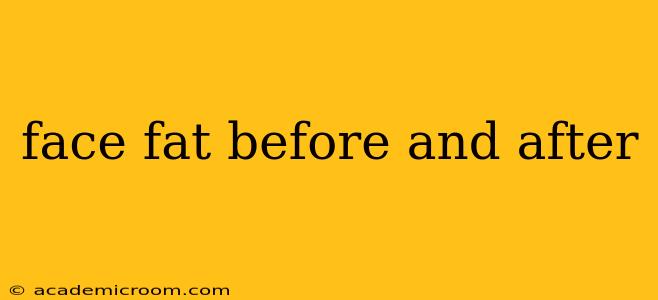Facial fat distribution is a common concern, influencing how we perceive our appearance and overall confidence. Many people search for "face fat before and after" images, hoping to find inspiration and understand the possibilities of reducing facial fullness. This comprehensive guide explores the multifaceted aspects of facial fat loss, examining different approaches, realistic expectations, and potential risks.
What Causes Facial Fat?
Several factors contribute to the accumulation of fat in the face. Understanding these underlying causes is crucial for developing an effective approach to facial slimming.
- Genetics: Hereditary factors significantly influence facial structure and fat distribution. Some individuals are naturally predisposed to having a fuller face.
- Weight Gain: Overall weight fluctuations directly impact facial fat. Weight loss often leads to a reduction in facial fullness.
- Age: As we age, skin loses elasticity and collagen, potentially leading to a sagging appearance that may appear as increased facial fat. This isn't necessarily an increase in fat itself but rather a change in skin structure.
- Fluid Retention: Temporary water retention can cause bloating, contributing to a fuller-looking face.
- Lifestyle Factors: Poor diet, lack of exercise, and insufficient sleep can all contribute to weight gain and, consequently, increased facial fat.
How Can I Lose Face Fat? (Addressing Common Concerns)
Many individuals seek quick fixes, but a holistic approach is often most effective. Let's address some common questions surrounding this topic.
Can I Spot Reduce Face Fat?
Unfortunately, spot reduction—targeting fat loss in a specific area like the face—is generally not possible. While facial exercises might improve muscle tone, they won't directly burn facial fat. Overall weight loss is key.
What Exercises Help Reduce Face Fat?
Facial exercises can help tone facial muscles and improve skin elasticity, potentially contributing to a more defined appearance. However, they are not a primary method for reducing facial fat. These exercises should be part of a larger strategy focused on overall health and well-being.
What are the Best Diets for Losing Face Fat?
There isn't a specific "face fat diet." The most effective approach is to adopt a healthy, balanced diet focused on whole foods, lean protein, fruits, vegetables, and limiting processed foods, sugary drinks, and excessive salt. A calorie deficit is essential for overall weight loss, including facial fat reduction.
Are There Non-Surgical Options for Reducing Facial Fat?
Yes, several non-surgical options can contribute to a slimmer facial appearance:
- Lifestyle Changes: Prioritizing a healthy diet, regular exercise, and sufficient sleep are fundamental.
- Facial Massage: Gentle massage can improve lymphatic drainage and potentially reduce puffiness.
- Skincare: Utilizing products designed to boost collagen production and improve skin elasticity can help address sagging skin.
What Surgical Options Are Available for Facial Fat Reduction?
Surgical options, such as liposuction or buccal fat removal, are more invasive and should be considered carefully. These procedures carry inherent risks and aren't suitable for everyone. Consult a board-certified plastic surgeon for a thorough evaluation and discussion of potential risks and benefits.
Realistic Expectations and Results
It's crucial to manage expectations. Facial fat loss is a gradual process. Results vary depending on individual factors like genetics, starting weight, and chosen methods. Dramatic before-and-after transformations often involve a combination of approaches and sometimes surgical intervention.
Conclusion: A Holistic Approach to a Slimmer Face
Achieving a slimmer face requires a comprehensive strategy. Focusing on overall health, adopting a balanced lifestyle, and exploring non-surgical options are often the most effective and safest ways to approach facial fat reduction. Surgical options should be considered only after careful consultation with a qualified medical professional and understanding the potential risks and benefits. Remember that consistency and patience are key to achieving positive and sustainable results.
